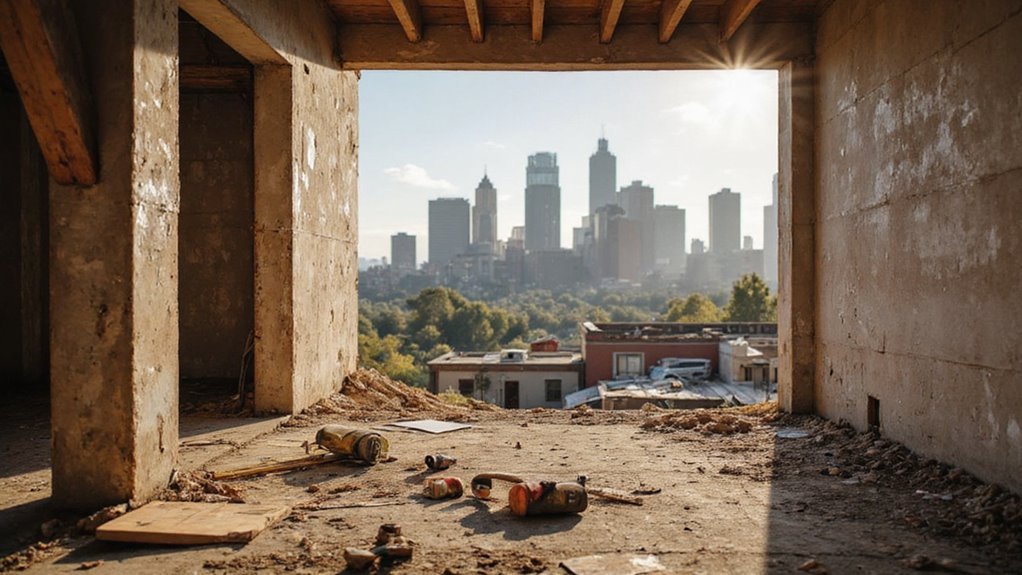Hard money bridge loans aren’t quite 100% financing, but they’re pretty close—you’ll typically borrow 65-90% of your property’s after-repair value, which is way more flexible than traditional banks. You’re borrowing against the property itself, not your credit score, so you’ll get approved in moments instead of months. Sure, you’ll pay higher interest rates (8-15%), but you’ll dodge credit delays and close swiftly. The real win? Interest-only payments keep your cash flowing while you renovate and flip. Stick around to uncover exactly how to maximize this strategy for your next project.
Key Takeaways
- Hard money bridge loans finance 65-90% of after-repair value, enabling rapid access to capital for fix-and-flip projects within days.
- Interest-only payments during renovation phases reduce monthly costs, improving cash flow management compared to traditional full mortgage obligations.
- Lenders prioritize deal quality and property equity over credit scores, accelerating approval based on experience and detailed renovation plans.
- Interest rates range from 8-15% with additional origination and processing fees that significantly impact project profitability and require careful planning.
- Customizable loan terms from 6 months to 3 years accommodate unique renovation timelines, providing flexibility for various exit strategies.
What Are Hard Money Bridge Loans?

A hard money bridge loan is basically a financial shortcut for real estate investors who need cash quickly. Unlike traditional banks that move at a snail’s pace, hard money bridge loan lenders approve funds in periods, not months. You’re getting short-term capital to bridge the gap between buying a property and securing long-term financing or completing your fix-and-flip project.
Here’s the deal: you’re borrowing against the property’s equity rather than your credit score. Hard money bridge loan lenders care about the deal itself—the numbers, the location, your exit strategy. These loans typically last 6-24 months, giving you breathing room to renovate and resell. This is perfect when timing’s everything and conventional banks won’t cut it. You’re basically trading higher interest rates for speed and flexibility. Bridge loans serve as interim financing to provide immediate cash flow until permanent financing is secured or the property is sold.
How Hard Money Bridge Loans Work for Fix & Flip Projects
When you’re ready for flipping a property, timing matters more than anything else—and that’s where hard money bridge loans really shine. Here’s how they function: you borrow against the property’s current value, not its potential after renovation. This signifies you can close quickly—sometimes in periods—while traditional lenders are still reviewing paperwork. You’ll use these funds for purchasing the property and covering initial renovation costs. The beauty? You’re not stuck making full mortgage payments while you work. Instead, you’re paying interest-only, which keeps your monthly costs down. Once you’ve completed renovations and the property’s value increases, you can refinance into a traditional mortgage or sell outright. It’s a smart move for investors who need speed and flexibility. These loans typically offer short-term funding to bridge capital gaps during renovation projects.
Financing Structure and Loan Terms Explained
When you’re structuring a hard money bridge loan for your fix and flip, you’ll want to understand how interest-only payments can keep your monthly costs lower during the renovation phase. Lenders typically base their loan-to-value ratios upon the property’s current condition or after-repair value, which directly impacts how much you can borrow and what your deal looks like financially. The best part? You can actually customize your loan terms in accordance with your project timeline, so you’re not stuck paying for months you don’t need the money. These temporary loans are designed to provide flexible financing options tailored specifically for industrial real estate projects.
Interest-Only Payment Structure
For fix and flip investors, the interest-only payment structure works like a financial runway that lets you keep your cash where it matters most—in the actual renovation. Instead of paying down principal each month, you’re covering just the interest, which means lower monthly payments during your project timeline. This breathing room is vital when you’re juggling contractor bills, material costs, and unexpected surprises (because they always happen). You’ll typically repay the full loan amount when you sell the property or refinance. It’s a smart move for investors who understand their exit strategy and want maximum flexibility. Think about it as paying rent on borrowed money rather than building equity on someone else’s schedule. Your capital stays liquid and ready for what is important.
Loan-to-Value Ratios Explained
Your lender’s willingness towards funding your fix and flip hinges largely regarding one critical number: the loan-value ratio, or LTV.
Think of LTV as your lender’s security blanket. It’s the percentage of your property’s value they’ll finance. Here’s what you need to know:
- LTV typically ranges from 65-80% for fix and flip projects
- Lower LTV means less risk for your lender and better rates for you
- Your down payment bridges the gap between the loan amount and total project cost
- After-repair value (ARV) matters most, not current condition
- Higher equity positions you stronger for refinancing or future deals
Understanding LTV enables you to structure smarter deals. You’re fundamentally showing lenders you’re seriously invested in your project’s success.
Flexible Term Customization Options
Unlike traditional bank mortgages that come with rigid, one-size-fits-all terms, hard money bridge loans offer you the flexibility in customizing your financing structure around your specific project needs. You’re not locked into standard 30-year repayment schedules that don’t match your fix-and-flip timeline.
Instead, you can negotiate loan terms—typically ranging from six months to three years—that align with your renovation timeline and exit strategy. Want interest-only payments during construction? Done. Need a balloon payment structure? You’ve got it. Hard money lenders understand that every project’s different, so they’ll work with you for customizing terms, interest rates, and repayment schedules that actually make sense for your deal. That’s the real advantage here.
Qualification Requirements and Approval Criteria

Since hard money bridge loans move more swiftly than traditional mortgages, lenders focus less regarding your credit score and more regarding the deal itself—which can be great news if you’ve had financial hiccups in the past.
Hard money bridge loans prioritize deal quality over credit scores, offering faster approval for investors with financial setbacks.
Here’s what lenders actually evaluate:
- Property equity and after-repair value (ARV) to confirm your project’s potential
- Your experience flipping similar properties in your market
- Detailed renovation plans showing realistic timelines and budgets
- Exit strategy demonstrating how you’ll repay the loan
- Down payment contribution proving your financial commitment
You’re not jumping through endless hoops or waiting months. Instead, lenders want proof your deal makes financial sense. They’re betting upon the property’s bones and your ability to execute, not your perfect credit history. That’s the innovation that makes hard money bridge loans transformative for serious investors. Additionally, since these loans are typically secured by collateral, such as the property itself, lenders assess the available collateral value to mitigate their risk.
Loan-to-Value Ratios and Maximum Financing Options
Most hard money lenders’ll finance somewhere between 65% and 80% for your property’s after-repair value, though some’ll go higher depending on the deal and your track record. Understanding these ratios helps you plan your fix-and-flip strategy more effectively.
| Financing Type | LTV Range |
|---|---|
| Conservative Lenders | 65-70% |
| Standard Programs | 70-80% |
| Aggressive Options | 80-90% |
| Portfolio Lenders | 75-85% |
| Experience-Based | 85%+ |
Your equity stake matters considerably. Lenders want skin in the game—it motivates you to complete projects successfully. If you’ve got a solid renovation plan and proven experience flipping properties, you’ll reveal better terms. Some innovative lenders’ll push toward 100% financing when your exit strategy’s bulletproof and your numbers stack up. That’s where real opportunity lives. Borrowers are increasingly turning to bridge lending options for flexible short-term financing amid shifting market conditions.
Key Benefits for Real Estate Investors
Now that you’ve got a handle over how much you can borrow against your property, let’s look at why hard money bridge loans have become the go-to financing option for real estate investors serious about fix-and-flip success.
These loans reveal opportunities that traditional banks simply won’t touch:
- Speed to funding – You’re closing in moments, not months, letting you snag deals before competitors do
- Flexibility regarding credit – Your past financial hiccups won’t disqualify you from capital
- Interest-only payments – You’re preserving cash flow during renovation phases when money’s tight
- Exit strategy options – You can refinance, sell, or utilize equity without rigid timelines
- Portfolio growth – You’re completing more projects annually, scaling your real estate empire quicker
Hard money bridge loans aren’t just financing—they’re your competitive edge in the fix-and-flip game. However, it’s important to be aware of the hidden risks involved in commercial bridge financing to make informed decisions.
Interest Rates and Associated Costs

While hard money bridge loans open up opportunities that traditional banks can’t match, they’ll cost you more upfront—and that’s something you need to comprehend before committing. You’re typically looking at interest rates between 8% and 15%, depending on your project’s risk level and your equity position. In addition to that, you’ll encounter origination fees, processing costs, and sometimes prepayment penalties. Yes, this stings compared to conventional mortgages, but remember: you’re gaining speed and flexibility that banks won’t provide you. Your fix-and-flip timeline matters. Calculate your total borrowing costs against your projected profits to verify the numbers actually work for your deal. That’s smart investing. Many key lenders specialize in providing these loans, offering tailored solutions for commercial bridge financing needs.
Risks to Consider Before Borrowing
Before you jump into a hard money bridge loan for your fix and flip, you’ve got to understand that those higher interest rates can eat into your profits more rapidly than you’d expect, especially if your project runs longer than planned. The clock’s ticking with bridge financing—lenders want their money back promptly, which means you’re facing real pressure to complete renovations and secure your exit strategy as scheduled or risk paying even more in accumulated interest. It’s the combination of these two forces that makes borrowers sometimes underestimate their true costs, so knowing exactly what you’re getting into helps you decide if that type of financing actually makes sense for your deal.
Interest Rate Burden
The price you’ll pay for quick access for capital is real, and that is worth understanding before you sign at the dotted line. Hard money loans come with higher interest rates than traditional mortgages, sometimes ranging from 8-15% annually. Here’s what you’re actually facing:
- Monthly payment shock: Your carrying costs climb quickly, eating into profits
- Rate variability: Rates fluctuate based upon market conditions and lender risk assessment
- Points and fees: Upfront costs add another 2-5% to your total borrowing expense
- Refinancing pressure: You’ll need strong exit strategies to avoid being stuck with expensive debt
- Timeline matters: Every extra month holding the loan compounds your interest burden
Bottom line? You’re paying premium prices for speed and flexibility. Make sure your project’s numbers can handle that.
Project Timeline Pressure
Beyond the sticker shock from those interest rates, there’s another monster lurking in your fix and flip timeline—and that is one that’ll keep you up at night if you’re not careful.
Hard money lenders impose strict deadlines for your project completion. You’ve got a specific window to finish renovations, sell the property, and repay the loan. Miss that deadline? You’re facing penalties and balloon payments that’ll drain your profits more quickly than water through a sieve.
Construction delays happen—weather, permits, contractor issues—they’re all real. With traditional financing, you’ve got breathing room. With hard money, you don’t. Every day that project sits incomplete costs you money in interest while your exit strategy unravels. You’re racing against a financial clock, which means higher stress and potentially rushed decisions that compromise your investment returns.
Common Scenarios and Real-World Applications
When you’re looking to turn a distressed property into profit, hard money bridge loans show up like that friend who always has cash at hand—ready to help when traditional banks won’t budge.
Real investors use these loans for situations like:
- Acquiring undervalued properties before competitors snatch them
- Covering renovation costs while securing permanent financing
- Managing timing gaps between property sales and purchases
- Building equity quickly regarding investment properties
- Bypassing credit delays that slow conventional loans
You’re basically getting immediate capital to seize opportunities. When you find a property with serious potential, you can’t wait six months for bank approvals. Hard money bridge loans let you move swiftly, renovate smart, and flip profitably. That’s innovation in real estate financing—getting money at crucial moments.
Choosing the Right Hard Money Lender for Your Project
Choosing the right hard money lender can make or break your fix-and-flip project, so this process is worth doing your homework before you sign anything. You’ll want to compare lenders based upon their interest rates, loan terms, and closing speed—because time’s money in this business. Look for lenders who understand your specific market and property type, whether that’s residential or commercial real estate. Check their track record with similar projects and read reviews from other borrowers. Don’t just grab the initial offer; shop around and ask tough questions about fees, prepayment penalties, and their exit strategy flexibility. A lender who gets your vision and offers competitive terms becomes your project partner, not just a funding source.






